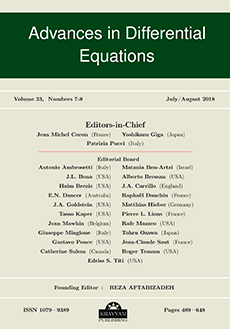Abstract
In this paper, for a bounded, smooth domain $\Omega \subset {{\mathbb {R}}}^N$, $h\in L^r(\Omega)$, $r>N/2$, $g\in L^s(\partial \Omega)$, $s>N-1$, we prove the maximum and antimaximum principle for the quasilinear boundary-value problem $- \mbox{div} ( A(u) \nabla u) +u = h$ in $\Omega$, $ A(u) \nabla u \cdot \eta = \lambda f(u) + g$, on $\partial \Omega$, where $A$ is elliptic and bounded and $f$ is asymptotically linear. The sharpness of this result ($r>N/2$ and $s>N-1$) is discussed for the linear boundary-value problem, $-\Delta u + u = h$ in $\Omega$, $\partial u/\partial\eta = \lambda u + g $ on $\partial \Omega$.
Citation
David Arcoya. Julio D. Rossi. "Antimaximum principle for quasilinear problems." Adv. Differential Equations 9 (9-10) 1185 - 1200, 2004. https://doi.org/10.57262/ade/1355867918
Information





